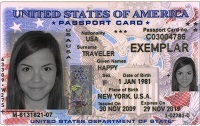lifestyle:hitting_the_road
This is an old revision of the document!
Table of Contents
“Pack as if you're going out for only a week during the summer. Then add what you'd need if you were going out for only a week in winter. That should pretty much cover everything.” –MrNoodly1)
“I can't be prepared for everything I can possibly imagine, so I prepare for things that are most likely to happen.” – MrNoodly2)
Hitting the road: a checklist
planning
- 
laying the groundwork
This section includes items that take a long time to do and/or that are beneficial to you whether or not you eventually hit the road.
 renew or apply for a passport. Having a passport makes getting a Real ID drivers license, etc, simpler. If your passport has expired, don't let it go more than 15 years from issuance for easiest renewal.3) The passport card (seen at right) may be a good choice for some folks.4) There are reports that getting a passport may be easier while you still have a sticks and bricks residence.5)
renew or apply for a passport. Having a passport makes getting a Real ID drivers license, etc, simpler. If your passport has expired, don't let it go more than 15 years from issuance for easiest renewal.3) The passport card (seen at right) may be a good choice for some folks.4) There are reports that getting a passport may be easier while you still have a sticks and bricks residence.5)- obtain originals or certified copies of birth certificate and other critical documents
- move check/savings/whatever to a bank or credit union that will meet your future needs. Services to consider: free ATM withdrawals nationwide,6) usable website.
- shred unnecessary documents, save critical originals, and scan the rest.
- request that direct mail marketers take your mailing address off their list
- optoutprescreen.com - credit card offers
- Direct Mail Association registration - $2 for 10 years. Recommended as “fastest way to see results” by the FTC.7)
one year out
This section assumes you are planning to hit the road sooner rather than later.
- decide if you are going to buy a camper, build one out of a cargo van, or use something you already own.
- if you are buying/building a camper: do the research, find a good one, buy it, and start your build (if required).
- stress-test your camper with short outings
- choose a domicile state. If you already live in a nomad-friendly state like Texas, South Dakota, or Florida, consider keeping it. Establish residency if you pick another state.
- decide on an address of your legal residence.
- research mail forwarders to find one that meets your criteria. It may be simpler to choose one in your domicile state.
- make general plans on where you would like to travel (or stay) in the first year of your RV life.
one month out
This section includes items that are best done while you still are in a physical residence.
- set up the account with your chosen mail forwarder
- start giving everyone our mailing address, letting them know you do not receive mail at your residence.
- If you want a P.O. Box get it before you move into your camper. USPS requires a mailing address to get a P.O. Box8)
- refill any prescriptions, get copies of medical records
- set termination dates for utilities, cable, etc.
- make specific plans about your first route or destination. Many new nomads travel widely9) in their first year, then move more methodically after that. Remember to limit driving to safe and relaxed intervals. The 3-30 rule is a common one: travel no more than 330 miles or after 3:30pm on any given day.
one week out
- fill out a change of address form for the post office, pointing to your mail forwarder. Note: if you call it a permanent change of address the USPS will sell your new address to junk mailers. If you mark it a temporary change the USPS will not sell the address, and you can renew the temporary change for another 6 months.10)
- change oil
- check tire pressure, etc as needed for your camper and/or tow vehicle.
one day out
- prepare the camper so all you have to do is leave the next day. Top off water supply, charge house batteries and all devices.
- move refrigerated foods to the camper's fridge
launch date
- take a long shower that morning! Showers are a rare luxury on the road.
- do a final walkthrough of your sticks & bricks home: stove off, refrigerator emptied and powered off with door[s] cracked.
- disconnect shore power, water lines, etc. from the camper
- do a walk-around of your camper. Anything out of place? On top? Underneath?
- check your mailbox for anything that missed forwarding
- pull away and start your new adventure
lifestyle/hitting_the_road.1551721825.txt.gz · Last modified: 2020/10/11 23:48 (external edit)

